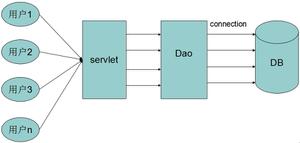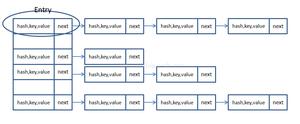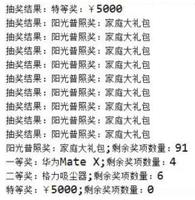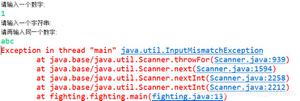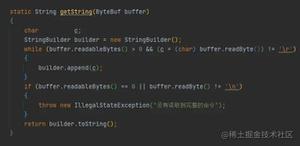【Java】HashMap底层原理剖析
HashMap
https://xueqiu.com/8674684995...
https://xueqiu.com/8674684995...
https://xueqiu.com/8674684995...
https://xueqiu.com/8674684995...
https://xueqiu.com/8674684995...
https://xueqiu.com/8674684995...
https://xueqiu.com/8674684995...
https://xueqiu.com/8674684995...
https://xueqiu.com/8674684995...
https://xueqiu.com/8674684995...
https://xueqiu.com/8674684995...
https://xueqiu.com/8674684995...
https://xueqiu.com/8674684995...
https://xueqiu.com/8674684995...
https://xueqiu.com/8674684995...
https://xueqiu.com/8674684995...
https://xueqiu.com/8674684995...
https://xueqiu.com/8674684995...
https://xueqiu.com/8674684995...
https://xueqiu.com/8674684995...
https://xueqiu.com/8674684995...
https://xueqiu.com/8674684995...
https://xueqiu.com/8674684995...
https://xueqiu.com/8674684995...
https://xueqiu.com/8674684995...
https://xueqiu.com/8674684995...
https://xueqiu.com/8674684995...
https://xueqiu.com/8674684995...
https://xueqiu.com/8674684995...
https://xueqiu.com/8674684995...
https://xueqiu.com/8674684995...
https://xueqiu.com/8674684995...
https://xueqiu.com/8674684995...
https://xueqiu.com/8674684995...
https://xueqiu.com/8674684995...
https://xueqiu.com/8674684995...
https://xueqiu.com/8674684995...
https://xueqiu.com/8674684995...
https://xueqiu.com/8674684995...
https://xueqiu.com/8674684995...
- HashMap底层原理剖析(超详细!!!)
- 一、散列表结构
- 二、什么是哈希?
- 三、HashMap原理讲解
- 3.1继承体系图
- 3.2Node数据结构分析
- 3.3底层存储结构
- 3.4put数据原理分析
- 3.5什么是哈希碰撞?
- 3.6JDK8为什么引入红黑树?
- 3.7扩容机制
- 四、手撕源码
- 1.HashMap核心属性分析
- 2.构造方法分析
- 3.put方法分析
- 4.resize()方法分析
- 5.get方法
- 6.remove方法分析
- 7.replace方法分析
HashMap底层原理剖析(超详细!!!)
一、散列表结构
散列表结构就是数组+链表的结构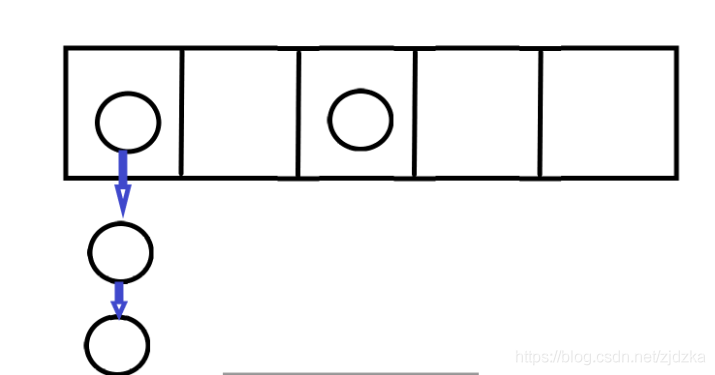
二、什么是哈希?
Hash也称散列、哈希,对应的英文单词Hash,基本原理就是把任意长度的输入,通过Hash算法变成固定长度的输出
这个映射的规则就是对应的哈希算法,而原始数据映射后的二进制就是哈希值
不同的数据它对应的哈希码值是不一样的
哈希算法的效率非常高
三、HashMap原理讲解
3.1继承体系图
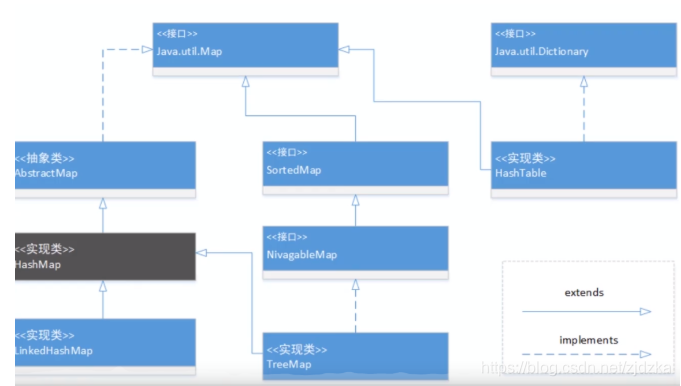
3.2Node数据结构分析
`static class Node<K,V> implements Map.Entry<K,V> {final int hash;计算得到哈希值
final K key;
V value;
Node<K,V> next;
}
interface Entry<K, V> {
K getKey();
V getValue();
V setValue(V value);`
* 1
* 2
* 3
* 4
* 5
* 6
* 7
* 8
* 9
* 10
* 11
3.3底层存储结构
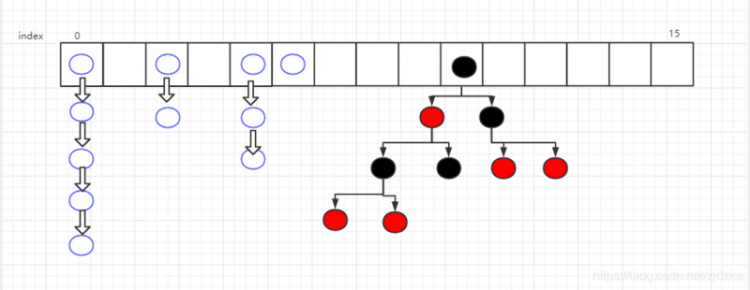
当链表长度到达8时,升级成红黑树结构
3.4put数据原理分析
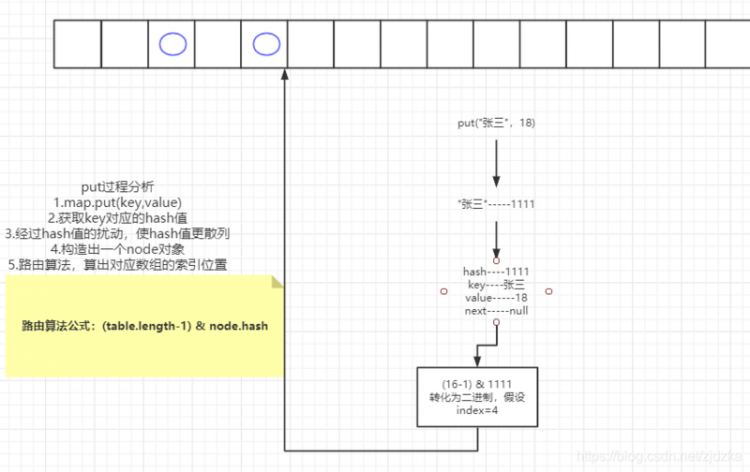
首先put进去一个key----value
根据key值会计算出一个hash值
经过扰动使数据更散列
构造出一个node对象
最后在通过路由算法得出一个对应的index
3.5什么是哈希碰撞?
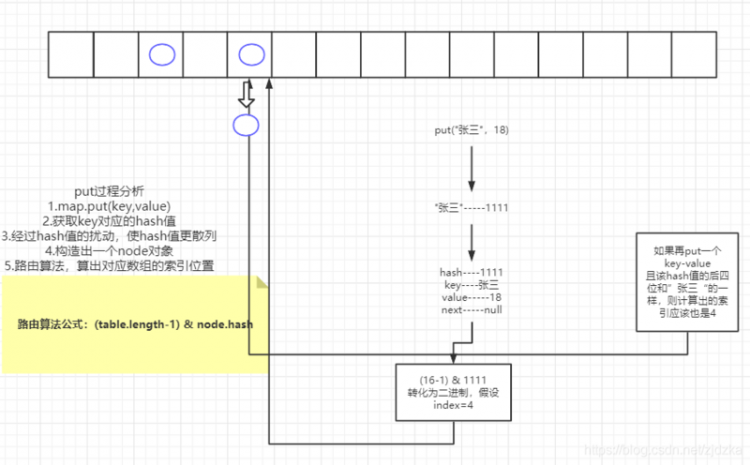
当传入的数据key对应计算出的hash值的后四位和上一个一样时,这时候计算出的index就会一致,就会发生碰撞,导致数据变成链表
例如:
(16-1)------->0000 0000 0000 1111
“张三”------->0100 1101 0001 1011
“李四”-------->1011 1010 0010 1011
此时,就会发现,张三和李四计算出的hash值转化为二进制的后四位一致,导致计算出index一致
3.6JDK8为什么引入红黑树?
哈希碰撞,会带来链化,效率会变低
引入红黑树会提高查找效率
3.7扩容机制
每次扩容为初始容量的2倍
eg:16------->32
为了防止数据过多,导致线性查询,效率变低,扩容使得桶数变多,每条链上数据变少,查询更快
四、手撕源码
1.HashMap核心属性分析
树化阈值-----8和64
负载因子0.75
threshold扩容阈值,当哈希表中的元素超过阈值时,触发扩容
loadFactory负载因子0.75,去计算阈值 eg:16*0.75
size-------当前哈希表中元素个数
modCount--------当前哈希表结构修改次数
2.构造方法分析
`public HashMap(int initialCapacity, float loadFactor) {//校验 小于0报错
if (initialCapacity < 0)
throw new IllegalArgumentException("Illegal initial capacity: " +
initialCapacity);
//capacity大于最大值取最大值
if (initialCapacity > MAXIMUM_CAPACITY)
initialCapacity = MAXIMUM_CAPACITY;
//负载因子不能小于等于0
if (loadFactor <= 0 || Float.isNaN(loadFactor))
throw new IllegalArgumentException("Illegal load factor: " +
loadFactor);
this.loadFactor = loadFactor;
//tableSizeFor方法
this.threshold = tableSizeFor(initialCapacity);
}
---------------------------------------------------------
//传入一个初始容量,默认负载因子0.75
public HashMap(int initialCapacity) {
this(initialCapacity, DEFAULT_LOAD_FACTOR);
}
---------------------------------------------------------
//无参数,负载因子默认0.75
public HashMap() {
this.loadFactor = DEFAULT_LOAD_FACTOR; // all other fields defaulted
}
---------------------------------------------------------
//传入一个map的对象
public HashMap(Map<? extends K, ? extends V> m) {
this.loadFactor = DEFAULT_LOAD_FACTOR;
putMapEntries(m, false);
}`
* 1
* 2
* 3
* 4
* 5
* 6
* 7
* 8
* 9
* 10
* 11
* 12
* 13
* 14
* 15
* 16
* 17
* 18
* 19
* 20
* 21
* 22
* 23
* 24
* 25
* 26
* 27
* 28
* 29
* 30
* 31
* 32
* 33
3.put方法分析
`public V put(K key, V value) {//返回putVal方法,给key进行了一次rehash
return putVal(hash(key), key, value, false, true);
}
----------------------------------------------------------
static final int hash(Object key) {
//让key对应的hash值的高16位也参与运算
int h;
return (key == null) ? 0 : (h = key.hashCode()) ^ (h >>> 16);
}
----------------------------------------------------------
final V putVal(int hash, K key, V value, boolean onlyIfAbsent,boolean evict)
{
//tab:引用当前HashMap的散列表
//p:表示当前散列表的元素
//n:表示散列表数组的长度
//i:表示路由寻址的结果
Node<K,V>[] tab; Node<K,V> p; int n, i;
---------------------------------------------------------- //延迟初始化逻辑,当第一次调用putVal的时候,才去初始化HashMap对象的散列表大小
if ((tab = table) == null || (n = tab.length) == 0)
n = (tab = resize()).length;
----------------------------------------------------------
//寻找找到桶位,且刚好为null,则把k-v封装成node对象放进去
if ((p = tab[i = (n - 1) & hash]) == null)
tab[i] = newNode(hash, key, value, null);
----------------------------------------------------------
else {
//e:不为null时,找到一个与当前要插入的key-val一致的key对象
//k:临时的一个key
Node<K,V> e; K k;
//表示桶位中的该元素,与你当前插入的元素key一致,后续会有替换操作
if (p.hash == hash &&
((k = p.key) == key || (key != null && key.equals(k))))
e = p;
----------------------------------------------------------
//树化
else if (p instanceof TreeNode)
e = ((TreeNode<K,V>)p).putTreeVal(this, tab, hash, key, value);
----------------------------------------------------------
else {
//链表的情况,而且链表的头元素与我们要插入的key不一致
for (int binCount = 0; ; ++binCount) {
//条件成立,即说明迭代到最后一个链表了,也没找到与你要插入的key一致的node对象
//说明要加入到链表的最后
if ((e = p.next) == null) {
p.next = newNode(hash, key, value, null);
//说明当前链表长度达到树化标准
if (binCount >= TREEIFY_THRESHOLD - 1) // -1 for 1st
treeifyBin(tab, hash);
break;
}
//说明找到的元素key一样,进行替换,break跳出循环即可
if (e.hash == hash &&
((k = e.key) == key || (key != null && key.equals(k))))
break;
p = e;
}
}
----------------------------------------------------------
//e不等于null,说明找到了一个与你插入元素完全一致的,进行替换
if (e != null) { // existing mapping for key
V oldValue = e.value;
if (!onlyIfAbsent || oldValue == null)
e.value = value;
afterNodeAccess(e);
return oldValue;
}
}
----------------------------------------------------------
//modCount:表示散列表结构被修改次数,替换元素不算次数
++modCount;
//插入新元素,size自增,如果自增大于扩容阈值,则触发扩容
if (++size > threshold)
resize();
afterNodeInsertion(evict);
return null;
}`
* 1
* 2
* 3
* 4
* 5
* 6
* 7
* 8
* 9
* 10
* 11
* 12
* 13
* 14
* 15
* 16
* 17
* 18
* 19
* 20
* 21
* 22
* 23
* 24
* 25
* 26
* 27
* 28
* 29
* 30
* 31
* 32
* 33
* 34
* 35
* 36
* 37
* 38
* 39
* 40
* 41
* 42
* 43
* 44
* 45
* 46
* 47
* 48
* 49
* 50
* 51
* 52
* 53
* 54
* 55
* 56
* 57
* 58
* 59
* 60
* 61
* 62
* 63
* 64
* 65
* 66
* 67
* 68
* 69
* 70
* 71
* 72
* 73
* 74
* 75
* 76
* 77
* 78
4.resize()方法分析
`//为了解决哈希冲突,影响哈希效率,所以会有扩容机制----------------------------------------------------------
final Node<K,V>[] resize() {
//oldTab:引用扩容前的哈希表
//oldCap:表示扩容前table的数组长度
//oldThr:表示扩容之前阈值
//newCap,newThr:扩容后的数组长度大小,以及扩容后下次的阈值
Node<K,V>[] oldTab = table;
int oldCap = (oldTab == null) ? 0 : oldTab.length;
int oldThr = threshold;
int newCap, newThr = 0;
----------------------------------------------------------
//条件成立,说明hashmap散列表已经初始化过了,这是一次正常扩容
if (oldCap > 0) {
//扩容之前的table数组大小,已经达到了最大阈值后,则不扩容
//且设置扩容条件为int最大值
if (oldCap >= MAXIMUM_CAPACITY) {
threshold = Integer.MAX_VALUE;
return oldTab;
}
----------------------------------------------------------
//oldCAP左移一位,实现数值翻倍,且赋值给newcap,newcap小于数值最大值限制 且扩容之前阈值>=16
//这种情况下,则下一次扩容阈值等于当前阈值翻倍
else if ((newCap = oldCap << 1) < MAXIMUM_CAPACITY &&
oldCap >= DEFAULT_INITIAL_CAPACITY)
newThr = oldThr << 1; // double threshold
}
---------------------------------------------------------- //oldCap == 0,说明hashmap散列表为null
//1.new HashMap(inttCap,loadFactor);
//2.new HashMap(inttCap);
//3.new HashMap(map); map有数据
else if (oldThr > 0) // initial capacity was placed in threshold
newCap = oldThr;//一定是2的次方数
----------------------------------------------------------
//oldCap==0,oldThr==0
//new HashMap();
else { // zero initial threshold signifies using defaults
newCap = DEFAULT_INITIAL_CAPACITY;
newThr = (int)(DEFAULT_LOAD_FACTOR * DEFAULT_INITIAL_CAPACITY);
}
----------------------------------------------------------
if (newThr == 0) {
float ft = (float)newCap * loadFactor;
newThr = (newCap < MAXIMUM_CAPACITY && ft < (float)MAXIMUM_CAPACITY ?
(int)ft : Integer.MAX_VALUE);
}
threshold = newThr;
----------------------------------------------------------
---------------------------------------------------------- //创建一个更长更大的数组
@SuppressWarnings({"rawtypes","unchecked"})
Node<K,V>[] newTab = (Node<K,V>[])new Node[newCap];
table = newTab;
//说明,hashmap本次扩容之前,table不为null
if (oldTab != null) {
for (int j = 0; j < oldCap; ++j) {
Node<K,V> e;//当前node节点
//说明当前桶位中有数据,但是具体是链表还是红黑树,还是单个数据,不确定
if ((e = oldTab[j]) != null) {
//方便jvm GC时回收
oldTab[j] = null;
//说明是个单个元素,直接计算当前元素应存放的新数组的位置即可
if (e.next == null)
newTab[e.hash & (newCap - 1)] = e;
//判断有没有树化成红黑树
else if (e instanceof TreeNode)
((TreeNode<K,V>)e).split(this, newTab, j, oldCap);
//第三种情况:桶位已经形成链表
else { // preserve order
//地位链表--存放在扩容之后的数组的下标位置,与当前数组的下标位置一致
Node<K,V> loHead = null, loTail=null;
//高位链表--存放在扩容之后的数组的下标位置为当前数组下标位置+扩容之前数组的长度
Node<K,V> hiHead = null, hiTail=null;
----------------------------------------------------------
Node<K,V> next;
do {
next = e.next;
//hash--……1 1111
//hash--……0 1111
//0b 10000
if ((e.hash & oldCap) == 0) {
if (loTail == null)
loHead = e;
else
loTail.next = e;
loTail = e;
}
else {
if (hiTail == null)
hiHead = e;
else
hiTail.next = e;
hiTail = e;
}
}
while ((e = next) != null);
//
if (loTail != null) {
loTail.next = null;
newTab[j] = loHead;
}
//
if (hiTail != null) {
hiTail.next = null;
newTab[j + oldCap] = hiHead;
}
}
}
}
}
return newTab;
}`
* 1
* 2
* 3
* 4
* 5
* 6
* 7
* 8
* 9
* 10
* 11
* 12
* 13
* 14
* 15
* 16
* 17
* 18
* 19
* 20
* 21
* 22
* 23
* 24
* 25
* 26
* 27
* 28
* 29
* 30
* 31
* 32
* 33
* 34
* 35
* 36
* 37
* 38
* 39
* 40
* 41
* 42
* 43
* 44
* 45
* 46
* 47
* 48
* 49
* 50
* 51
* 52
* 53
* 54
* 55
* 56
* 57
* 58
* 59
* 60
* 61
* 62
* 63
* 64
* 65
* 66
* 67
* 68
* 69
* 70
* 71
* 72
* 73
* 74
* 75
* 76
* 77
* 78
* 79
* 80
* 81
* 82
* 83
* 84
* 85
* 86
* 87
* 88
* 89
* 90
* 91
* 92
* 93
* 94
* 95
* 96
* 97
* 98
* 99
* 100
* 101
* 102
* 103
* 104
* 105
* 106
* 107
* 108
* 109
* 110
* 111
* 112
5.get方法
`public V get(Object key) {Node<K,V> e;
return (e = getNode(key)) == null ? null : e.value;
}
----------------------------------------------------------
final Node<K,V> getNode(Object key) {
Node<K,V>[] tab; //tab:引用当前hashmap的散列表
Node<K,V> first, e;//first:桶位中的头元素,e:临时node元素
int n, hash; //n:table数组长度
K k;
---------------------------------------------------------
if ((tab = table) != null && (n = tab.length) > 0 &&
(first = tab[(n - 1) & (hash = hash(key))]) != null) {
//定位出来的桶位元素,就是我们要get的元素
if (first.hash == hash && // always check first node
((k = first.key) == key || (key != null && key.equals(k))))
return first;
---------------------------------------------------------- //说明当前桶位不止一个元素,可能是树或者链表
if ((e = first.next) != null) {
if (first instanceof TreeNode)
return ((TreeNode<K,V>)first).getTreeNode(hash, key);
---------------------------------------------------------- //链表的情况
do {
if (e.hash == hash &&
((k = e.key) == key || (key != null && key.equals(k))))
return e;
} while ((e = e.next) != null);
}
}
return null;
}`
* 1
* 2
* 3
* 4
* 5
* 6
* 7
* 8
* 9
* 10
* 11
* 12
* 13
* 14
* 15
* 16
* 17
* 18
* 19
* 20
* 21
* 22
* 23
* 24
* 25
* 26
* 27
* 28
* 29
* 30
* 31
6.remove方法分析
`public V remove(Object key) {Node<K,V> e;
return (e = removeNode(hash(key), key, null, false, true)) == null ?
null : e.value;
}
----------------------------------------------------------
final Node<K,V> removeNode(int hash, Object key, Object value,boolean matchValue, boolean movable) {
//tab:引用当前HashMap的散列表
//p:表示当前散列表的元素
//n:表示散列表数组的长度
//index:表示路由寻址的结果
Node<K,V>[] tab; Node<K,V> p; int n, index;
----------------------------------------------------------
if ((tab = table) != null && (n = tab.length) > 0 &&(p = tab[index = (n - 1) & hash]) != null) {
//说明路由的桶位是有数据的,需要进行查找操作,且删除
---------------------------------------------------------- //node:查找到的结果, e:当前node的下一个元素
Node<K,V> node = null, e; K k; V v;
//当前桶位中的元素即为要删除的元素
if (p.hash == hash &&
((k = p.key) == key || (key != null && key.equals(k))))
node = p;
---------------------------------------------------------- //当前桶位的元素为红黑树
else if ((e = p.next) != null) {
if (p instanceof TreeNode)
node=((TreeNode<K,V>)p).getTreeNode(hash, key);
---------------------------------------------------------- //当前桶位为链表
else {
do {
if (e.hash == hash &&
((k = e.key) == key ||
(key != null && key.equals(k)))) {
node = e;
break;
}
p = e;
} while ((e = e.next) != null);
}
}
---------------------------------------------------------- //判断node不为空的情况,说明按照key找到了要删除的数据
if (node != null && (!matchValue || (v = node.value) == value ||(value != null&&value.equals(v)))) {
//结果是红黑树
if (node instanceof TreeNode) ((TreeNode<K,V>)node).removeTreeNode(this, tab, movable);
//结果为单个元素
else if (node == p)
tab[index] = node.next;
//结果为链表
else
p.next = node.next;
++modCount;//修改次数自增
--size;//长度减少
afterNodeRemoval(node);
return node;
}
}
return null;
}`
* 1
* 2
* 3
* 4
* 5
* 6
* 7
* 8
* 9
* 10
* 11
* 12
* 13
* 14
* 15
* 16
* 17
* 18
* 19
* 20
* 21
* 22
* 23
* 24
* 25
* 26
* 27
* 28
* 29
* 30
* 31
* 32
* 33
* 34
* 35
* 36
* 37
* 38
* 39
* 40
* 41
* 42
* 43
* 44
* 45
* 46
* 47
* 48
* 49
* 50
* 51
* 52
* 53
* 54
* 55
* 56
7.replace方法分析
@Overridepublic boolean replace(K key, V oldValue, V newValue) {
Node<K,V> e; V v;
if ((e = getNode(key)) != null &&
((v = e.value) == oldValue || (v != null && v.equals(oldValue)))) {
e.value = newValue;
afterNodeAccess(e);
return true;
}
return false;
}
----------------------------------------------------------
@Override
public V replace(K key, V value) {
Node<K,V> e;
if ((e = getNode(key)) != null) {
V oldValue = e.value;
e.value = value;
afterNodeAccess(e);
return oldValue;
}
return null;
}
ll && v.equals(oldValue)))) {
e.value = newValue;
afterNodeAccess(e);
return true;
}
return false;
}
----------------------------------------------------------
@Override
public V replace(K key, V value) {
Node<K,V> e;
if ((e = getNode(key)) != null) {
V oldValue = e.value;
e.value = value;
afterNodeAccess(e);
return oldValue;
}
return null;
}
以上是 【Java】HashMap底层原理剖析 的全部内容, 来源链接: utcz.com/a/95596.html

